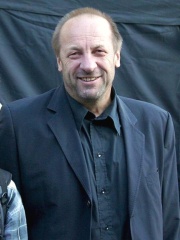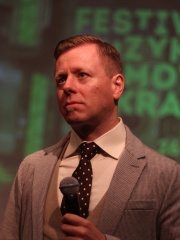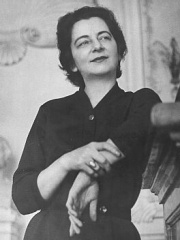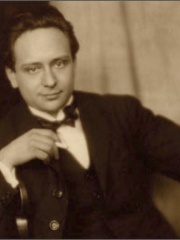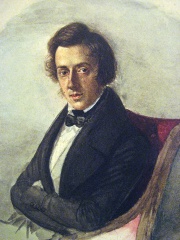
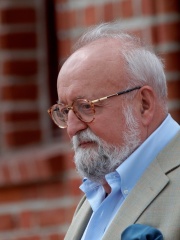
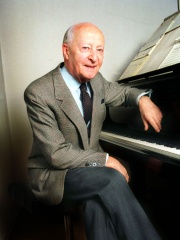
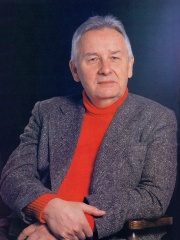
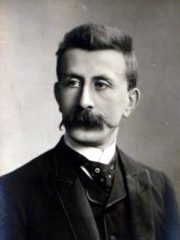
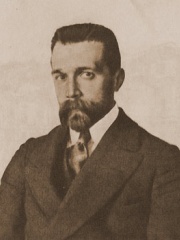
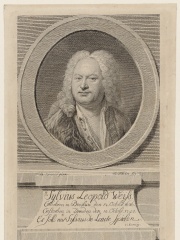
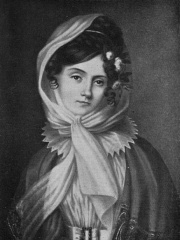
The Most Famous
COMPOSERS from Poland
Top 10
The following people are considered by Pantheon to be the top 10 most legendary Polish Composers of all time. This list of famous Polish Composers is sorted by HPI (Historical Popularity Index), a metric that aggregates information on a biography's online popularity. Visit the rankings page to view the entire list of Polish Composers.

1. Frédéric Chopin (1810 - 1849)
With an HPI of 92.48, Frédéric Chopin is the most famous Polish Composer. His biography has been translated into 163 different languages on wikipedia.
Frédéric François Chopin (born Fryderyk Franciszek Chopin; 1 March 1810 – 17 October 1849) was a Polish composer and virtuoso pianist of the Romantic period who wrote primarily for solo piano. He has maintained worldwide renown as a leading composer of his era whose "poetic genius was based on a professional technique that was without equal in his generation". Chopin was born in Żelazowa Wola and grew up in Warsaw, which in 1815 became part of Congress Poland. A child prodigy, he completed his musical education and composed his early works in Warsaw before leaving Poland at age 20, less than a month before the outbreak of the November 1830 Uprising; at 21, he settled in Paris. Thereafter he gave only 30 public performances, preferring the more intimate atmosphere of the salon. He supported himself, selling his compositions and giving piano lessons, for which he was in high demand. Chopin formed a friendship with Franz Liszt and was admired by many musical contemporaries, including Robert Schumann. After a failed engagement to Maria Wodzińska from 1836 to 1837, he maintained an often troubled relationship with the French writer Aurore Dupin (known by her pen name George Sand). A brief and unhappy visit to Mallorca with Sand in 1838–39 proved one of his most productive periods of composition. In his final years he was supported financially by his admirer Jane Stirling. In poor health most of his life, Chopin died in Paris in 1849 at age 39. All of Chopin's compositions feature the piano. Most are for solo piano, though he also wrote two piano concertos before leaving Warsaw, some chamber music, and 19 songs set to Polish lyrics. His piano pieces are technically demanding and expanded the limits of the instrument; his own performances were noted for their nuance and sensitivity. Chopin's major piano works include mazurkas, waltzes, nocturnes, polonaises, the instrumental ballade (which Chopin created as an instrumental genre), études, impromptus, scherzi, preludes, and sonatas, some published only posthumously. Among the influences on his style of composition were Polish folk music, the classical tradition of Mozart and Schubert, and the atmosphere of the Paris salons, of which he was a frequent guest. His innovations in style, harmony, and musical form, and his association of music with nationalism, were influential throughout and after the late Romantic period. Chopin's music, his status as one of music's earliest celebrities, his indirect association with political insurrection, his high-profile love life, and his early death have made him a leading symbol of the Romantic era. His works remain popular, and he has been the subject of numerous films and biographies of varying historical fidelity. Among his many memorials is the Fryderyk Chopin Institute, which was created by the Polish parliament to research and promote his life and works, and which hosts the prestigious International Chopin Piano Competition, devoted entirely to his works.

2. Krzysztof Penderecki (1933 - 2020)
With an HPI of 73.16, Krzysztof Penderecki is the 2nd most famous Polish Composer. His biography has been translated into 54 different languages.
Krzysztof Eugeniusz Penderecki (Polish: [ˈkʂɨʂtɔf pɛndɛˈrɛt͡skʲi] ; 23 November 1933 – 29 March 2020) was a Polish composer and conductor. His best-known works include Threnody to the Victims of Hiroshima, Symphony No. 3, his St Luke Passion, Polish Requiem, Anaklasis and Utrenja. His oeuvre includes five operas, eight symphonies and other orchestral pieces, a variety of instrumental concertos, choral settings of mainly religious texts, as well as chamber and instrumental works. After graduating from the Academy of Music in Krakow, he became a teacher there and began his career as a composer in 1959 during the Warsaw Autumn festival. His Threnody to the Victims of Hiroshima for string orchestra and the choral work St. Luke Passion have received popular acclaim. His first opera, The Devils of Loudun, was never successful despite repeated revisions. In the mid-1970s, Penderecki became a professor at the Yale School of Music. From the mid-1970s his composition style changed, with his first violin concerto focusing on the semitone and the tritone. His choral work Polish Requiem was written in the 1980s and expanded in 1993 and 2005. Penderecki won many prestigious awards, including the Prix Italia in 1967 and 1968; the Wihuri Sibelius Prize of 1983; four Grammy Awards in 1987, 1998 (twice), and 2017; the Wolf Prize in Arts in 1987; and the University of Louisville Grawemeyer Award for Music Composition in 1992. In 2012, Sean Michaels of The Guardian called him "arguably Poland's greatest living composer". In 2020 the composer's alma mater, the Academy of Music in Kraków, was renamed in his honour.

3. Witold Lutosławski (1913 - 1994)
With an HPI of 69.78, Witold Lutosławski is the 3rd most famous Polish Composer. His biography has been translated into 43 different languages.
Witold Roman Lutosławski (Polish: [ˈvitɔld lutɔˈswafski] ; 25 January 1913 – 7 February 1994) was a Polish composer and conductor. Among the major composers of 20th-century classical music, he is "generally regarded as the most significant Polish composer since Szymanowski, and possibly the greatest Polish composer since Chopin". His compositions—of which he was a notable conductor—include representatives of most traditional genres, aside from opera: symphonies, concertos, orchestral song cycles, other orchestral works, and chamber works. Among his best known works are his four symphonies, the Variations on a Theme by Paganini (1941), the Concerto for Orchestra (1954), and his cello concerto (1970). During his youth, Lutosławski studied piano and composition in Warsaw. His early works were influenced by Polish folk music and demonstrated a wide range of rich atmospheric textures. His folk-inspired music includes the Concerto for Orchestra (1954)—which first brought him international renown—and Dance Preludes (1955), which he described as a "farewell to folklore". From the late 1950s he began developing new, characteristic composition techniques. He introduced limited aleatoric elements, while retaining tight control of his music's material, architecture, and performance. He also evolved his practice of building harmonies from small groups of musical intervals. During World War II, after narrowly escaping German capture, Lutosławski made a living playing the piano in Warsaw bars. After the war, Stalinist authorities banned his First Symphony for being "formalist": accessible only to an elite. Rejecting anti-formalism as an unjustified retrograde step, Lutosławski resolutely strove to maintain his artistic integrity, providing artistic support to the Solidarity movement throughout the 1980s. He received numerous awards and honours, including the Grawemeyer Award and a Royal Philharmonic Society Gold Medal. In 1994, Lutosławski was awarded Poland's highest honour, the Order of the White Eagle.

4. Henryk Górecki (1933 - 2010)
With an HPI of 67.88, Henryk Górecki is the 4th most famous Polish Composer. His biography has been translated into 45 different languages.
Henryk Mikołaj Górecki ( gə-RET-skee; Polish: [ˈxɛnrɨk miˈkɔwaj ɡuˈrɛt͡skʲi] ; 6 December 1933 – 12 November 2010) was a Polish composer of contemporary classical music. According to critic Alex Ross, no recent classical composer has had as much commercial success as Górecki. He became a leading figure of the Polish avant-garde during the post-Stalin cultural thaw. His Anton Webern-influenced serialist works of the 1950s and 1960s were characterized by adherence to dissonant modernism and influenced by Luigi Nono, Karlheinz Stockhausen, Krzysztof Penderecki and Kazimierz Serocki. He continued in this direction throughout the 1960s, but by the mid-1970s had changed to a less complex sacred minimalist sound, exemplified by the transitional Symphony No. 2 and the Symphony No. 3 (Symphony of Sorrowful Songs). This later style developed through several other distinct phases, from such works as his 1979 Beatus Vir, to the 1981 choral hymn Miserere, the 1993 Kleines Requiem für eine Polka and his requiem Good Night. Górecki was largely unknown outside Poland until the late 1980s. In 1992, 15 years after it was composed, a recording of his Symphony of Sorrowful Songs with soprano Dawn Upshaw and conductor David Zinman became a worldwide commercial and critical success, selling more than a million copies and vastly exceeding the typical lifetime sales of a recording of symphonic music by a 20th-century composer. Commenting on its popularity, Górecki said, "Perhaps people find something they need in this piece of music ... somehow I hit the right note, something they were missing. Something somewhere had been lost to them. I feel that I instinctively knew what they needed." This popular acclaim did not generate wide interest in Górecki's other works, and he pointedly resisted the temptation to repeat earlier success, or compose for commercial reward. Apart from two brief periods studying in Paris and a short time living in Berlin, Górecki spent most of his life in southern Poland.

5. Martin Agricola (1486 - 1556)
With an HPI of 67.35, Martin Agricola is the 5th most famous Polish Composer. His biography has been translated into 28 different languages.
Martin Agricola (6 January 1486 – 10 June 1556) was a German composer of Renaissance music and a music theorist.

6. Moritz Moszkowski (1854 - 1925)
With an HPI of 67.05, Moritz Moszkowski is the 6th most famous Polish Composer. His biography has been translated into 26 different languages.
Moritz Moszkowski (Polish: Maurycy Moszkowski) (23 August 1854 – 4 March 1925) was a German-Polish composer, pianist, and teacher. His brother Alexander Moszkowski was a famous writer and satirist in Berlin. Ignacy Paderewski said: "After Chopin, Moszkowski best understands how to write for the piano, and his writing embraces the whole gamut of piano technique." Although less known today, Moszkowski was well respected and popular during the late nineteenth century.

7. Nikolai Myaskovsky (1881 - 1950)
With an HPI of 67.03, Nikolai Myaskovsky is the 7th most famous Polish Composer. His biography has been translated into 37 different languages.
Nikolai Yakovlevich Myaskovsky (Russian: Никола́й Я́ковлевич Мяско́вский; Polish: Mikołaj Miąskowski; 20 April 1881 – 8 August 1950), was a Russian and Soviet composer. He is sometimes referred to as the "Father of the Soviet Symphony". Myaskovsky was awarded the Stalin Prize five times.

8. Sylvius Leopold Weiss (1687 - 1750)
With an HPI of 66.95, Sylvius Leopold Weiss is the 8th most famous Polish Composer. His biography has been translated into 27 different languages.
Sylvius Leopold Weiss (1687–1750) was a German composer and lutenist. Born in Grottkau near Breslau, the son of Johann Jacob Weiss, also a lutenist, Weiss was one of the most important and most prolific composers of lute music in history and one of the best-known and most technically accomplished lutenists of his day. In later life, Weiss became a friend of Wilhelm Friedemann Bach and met J.S. Bach through him. Bach and Weiss were said to have competed in improvisation.

9. Maria Szymanowska (1789 - 1831)
With an HPI of 66.85, Maria Szymanowska is the 9th most famous Polish Composer. Her biography has been translated into 29 different languages.
Maria Szymanowska (Polish pronunciation: [ˈmarja ʂɨmaˈnɔfska]; born Marianna Agata Wołowska; Warsaw, 14 December 1789 – 25 July 1831, St. Petersburg, Russia) was a Polish composer and one of the first professional virtuoso pianists of the 19th century. She toured extensively throughout Europe, especially in the 1820s, before settling permanently in St. Petersburg. In the Russian imperial capital, she composed for the court, gave concerts, taught music, and ran an influential salon. Salons were popular in 18th-century France. They were regular intellectual gatherings held at home by educated women. In 1837, the composer and music critic Robert Schumann defined salon music as elegant light music and stated that this type of social music should sound beautiful, delicate, and fashionable. Szymanowska was highly praised by Schumann for her salon music works, especially her etudes. Her compositions—largely piano pieces, songs, and other small chamber works, as well as the first piano concert etudes and nocturnes in Poland—typify the stile brillant of the era preceding Frédéric Chopin. She was the mother of Celina Szymanowska, who married the Polish Romantic poet Adam Mickiewicz.
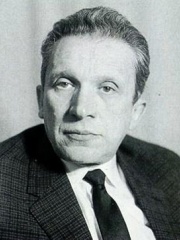
10. Mieczysław Weinberg (1919 - 1996)
With an HPI of 66.25, Mieczysław Weinberg is the 10th most famous Polish Composer. His biography has been translated into 22 different languages.
Mieczysław Weinberg (December 8, 1919 – February 26, 1996) was a Polish, Soviet, and Russian composer and pianist. Born in Warsaw to parents who worked in the Yiddish theatre in Poland, his early years were surrounded by music. At the age of 12, he began formal music lessons. Later, he studied piano at the Warsaw Conservatory. In 1939, Weinberg fled Warsaw when Germany invaded Poland and started World War II. His family was later murdered at the Trawniki concentration camp. Weinberg found refuge in the Soviet Union. He established himself successfully in Moscow with support from Dmitri Shostakovich and the Committee on the Arts. Postwar changes in Soviet cultural policy led to increased persecution of minority groups, including Jews. Although Weinberg's music was well regarded and regularly played, he was surveilled and harassed by the MVD. On February 6, 1953, Weinberg was arrested and jailed at Lubyanka Prison. Intercession on his behalf by Shostakovich and Stalin's death led to Weinberg's release on April 25. The 1960s were the peak of Weinberg's professional success. Aside from his concert works, his music for film also became well known. His score for Fyodor Khitruk's cartoon Winnie-the-Pooh was an immediate success and the verses sung by its titular character entered the Russian popular lexicon. In the 1970s, Weinberg career began to decline, in spite of increased official distinctions. He continued to compose prolifically through the 1980s, but health problems aggravated by the loss of state patronage and healthcare that resulted from the collapse of the Soviet Union left him bedridden in his final years. Belated recognition of his music outside of Russia began in the 1990s through the advocacy of Tommy Persson, a Swedish judge. In 1994, Poland awarded Weinberg the Meritorious Activist of Culture. He converted to Orthodox Christianity a few weeks before his death.
People
Pantheon has 40 people classified as Polish composers born between 1486 and 1978. Of these 40, 3 (7.50%) of them are still alive today. The most famous living Polish composers include Zbigniew Preisner, Abel Korzeniowski, and Agata Zubel. The most famous deceased Polish composers include Frédéric Chopin, Krzysztof Penderecki, and Witold Lutosławski.
Living Polish Composers
Go to all RankingsZbigniew Preisner
1955 - Present
HPI: 61.46
Abel Korzeniowski
1972 - Present
HPI: 51.40
Agata Zubel
1978 - Present
HPI: 40.04
Deceased Polish Composers
Go to all RankingsFrédéric Chopin
1810 - 1849
HPI: 92.48
Krzysztof Penderecki
1933 - 2020
HPI: 73.16
Witold Lutosławski
1913 - 1994
HPI: 69.78
Henryk Górecki
1933 - 2010
HPI: 67.88
Martin Agricola
1486 - 1556
HPI: 67.35
Moritz Moszkowski
1854 - 1925
HPI: 67.05
Nikolai Myaskovsky
1881 - 1950
HPI: 67.03
Sylvius Leopold Weiss
1687 - 1750
HPI: 66.95
Maria Szymanowska
1789 - 1831
HPI: 66.85
Mieczysław Weinberg
1919 - 1996
HPI: 66.25
Grażyna Bacewicz
1909 - 1969
HPI: 65.78
Viktor Ullmann
1898 - 1944
HPI: 65.53
Overlapping Lives
Which Composers were alive at the same time? This visualization shows the lifespans of the 25 most globally memorable Composers since 1700.

